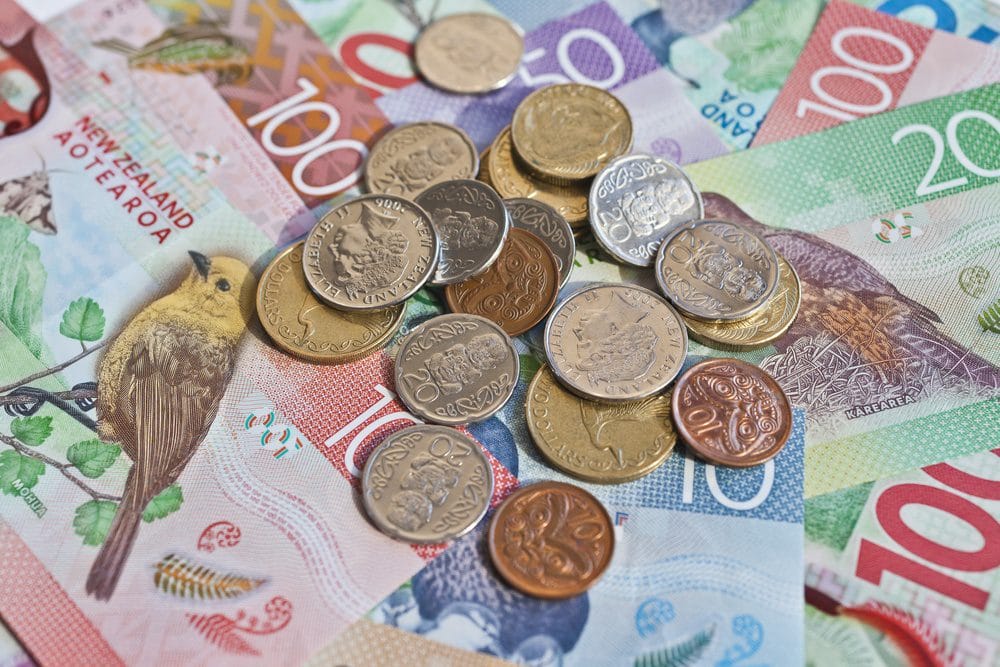Introducing NZDCHF
The New Zealand Dollar (NZD) and the Swiss Franc (CHF) make up the NZDCHF currency pair. The NZD is New Zealand’s national currency, while the CHF is Switzerland’s national currency. The NZD is the world’s ninth most traded currency, while the CHF is the world’s tenth most traded currency. Together, the NZDCHF is the world’s tenth most traded currency pair. The NZD is well-known because to its geographic position and strong economy. The CHF is widely used because Switzerland has a reasonably strong economy that makes it appealing for keeping financial assets. Before we get into how to trade the NZDCHF currency pair, let’s first explore the historical significance of the New Zealand Dollar and Swiss Franc.
The New Zealand Dollar
In 1967, the New Zealand Dollar, abbreviated as NZD, was launched. It is the ninth most widely used currency in the world. Previously, New Zealand’s currency was the New Zealand Pound. The New Zealand Dollar maintained a fixed exchange rate with the US Dollar until 1985. Only after 1985, they were allowed to use their own variable rates.
Their physical notes have undergone several alterations over the years in order to be more visually appealing while also being more secure. In 1999, New Zealand changed the composition of its banknotes from paper to polymer and plastic. This was done to make counterfeit notes much simpler to identify. This also makes the notes waterproof and more difficult to disassemble. Their notes’ printing is well-known for being very colorful, and they are always improving the pattern to make it more attractive.
The Swiss Franc
The Swiss Franc is the national currency of both Switzerland and Lichtenstein. It is one of the currencies that has not been removed from the EU as a result of the Euro’s adoption. Switzerland wished to keep its own currency, the CHF. The Swiss franc is the tenth most popular currency in terms of trading volume.
It accounts for 1% of the daily transaction volume in the industry. It is also the world’s eighth most often stored reserve currency. Swiss Franc notes are issued by the Swiss National Bank. Switzerland is a popular destination for holding financial assets since it has one of the greatest private banking systems in the world. It is also a popular storage location since Switzerland is believed to have one of the world’s most stable economies.
Why Trade NZDCHF
Both New Zealand and Switzerland belong to two completely different regions which makes them quite intriguing as a currency pair. This is because they bring unique trading conditions from two different parts of the world. Here is why you should trade NZDCHF:
Cross-Currency Pair
The fact that the NZDCHF pair is a cross-currency is one of the most compelling reasons to trade it. As a consequence, it might substantially increase the range of assets that you deal in this market. Trading the same big currency pairings over and again might become tiresome after a time. You’ll spend the entire day keeping an eye on the same market dynamics. Trading a cross-currency pair is similar to going on a trip to a place you’ve never been before. You’ll discover how markets operate when the USD is absent. You’ll also be able to engage in cross-trades, which we’ll discuss in further detail later.
Market Predictability
The NZDCHF market conditions are very predictable. This is because changes in their respective nations, New Zealand and Switzerland, have the most extent of influence on them. Because the USD is the standard currency for international transactions, any changes anywhere in the globe will affect a pair that includes the USD. Similarly, changes in any of the European Union’s 28 member countries would affect a pair including the Euro. As a result, it becomes impossible to keep track of every place that may have an influence on a currency pair. Currency pairings that are merely linked to a certain area, such as NZDCHF, are significantly easier to study because we just need to evaluate their particular nations.
Interest Rates
New Zealand is well-known for its central bank’s high interest rates. These high interest rates are considerably higher than those of market giants such as the United States, the United Kingdom, and Australia. Traders are drawn to the NZDCHF currency pair due to its high interest yields as a result of these high interest rates. It has high interest yields as Switzerland has one of the lowest interest rates in the market. This pair provides significant yields due to the large disparity in interest rates between them. Because of the large payouts, traders frequently utilize a carry trade when trading this currency pair. Carry trade is the practice of selling a currency with a low interest rate in order to purchase one with a higher interest rate.
NZDCHF Trading Tips
Since New Zealand and Switzerland are from very different parts of the world, they may present some unique trading circumstances. Due to this, it is important to know some key tips when trading in their markets. Here are the top trading tips for the NZDCHF currency pair:
Day Trading
Day trading is a trading strategy that involves opening and closing a deal on the same day. Before the market closes, all transactions, whether lucrative or not, must be completed. Scalping is a common trading method for this trading style. Traders would open a BUY and SELL position for the same currency pair at the same rate. This enables them to profit regardless of how the market fluctuates. When the market falls, they profit from the opposite position they take. This strategy is great for the NZDCHF since this volatile pair may be rather turbulent at times. Day trading, particularly scalping, is an effective strategy for collecting profits between changing market conditions during moments of volatility.
Trend Trading
Trend trading is all about identifying trends on trading charts and using them to make trades. Detecting an uptrend and a downtrend are two of the most common patterns that traders look for. These represent bullish and bearish market conditions, respectively. When the highs and lows both climb, the market is in an uptrend. A downtrend happens when both the lows and highs decline. Because you can recognize trend patterns just by looking at a chart, this is a reasonably simple trading approach that anyone can understand. Because the NZDCHF is recognized for having long upward and negative trends, this is an ideal strategy for this currency pair.
Carry Trading
Carry trade is the practice of borrowing a low-interest-rate currency in order to invest in a higher-interest-rate currency. When employing the carry trade strategy, you must first select your funding and asset currencies. The currency utilized in the transaction is known as the funding currency. This currency is typically linked to a lower interest rate. Historically, the CHF has been a favored funding currency. Selling the CHF while also acquiring the NZD is critical for good NZDCHF carry trading. When this happens, you will be paid interest depending on the enormous difference in interest rates between NZD and CHF.
Factors Affecting NZDCHF
Although as we’ve mentioned, New Zealand and Switzerland belong to two completely different regions, they’re pretty similar to each other in terms of being the choice destination for vacations. They both also some of the most stable economies in the world. Here are some top factors affecting NZDCHF:
Financial Institutions
Both the Reserve Bank of New Zealand and the Swiss National Bank are majorly responsible for any instability in the NZDCHF marketplace. The RBNZ and SNB release monthly reports and statements regarding updates to any policy changes. These reports also display the economic and monetary forecasts for the upcoming short-term.
Any positive results from the RBNZ will have a positive impact on the NZDCHF currency pair. However, any positive results from the SNB will have an inverse impact on the NZDCHF currency pair. The representatives of these individual banks also hold speeches frequently where they explain these results in more detail. These speeches are just, if not more, important in determining the direction of the NZDCHF market. From RBNZ, Adrian Orr who is the Governor of the institution is highly looked upon for his speeches. From SNB, Thomas Jordan who is the Governor of the institution is highly looked upon for his speeches.
The Dairy Markets
Any changes in the dairy industry will have a substantial impact on the NZDCHF currency pair. This is due to the fact that New Zealand is the world’s leading exporter of whole milk powder. Their economy is mainly based on commodities demand. If demand for these goods increases, the NZDCHF will benefit significantly.
Similarly, if demand for this product declines, the value of the NZDCHF falls as the New Zealand economy suffers. We can look at it from a monetary aspect as well. A rise in the price of specific types of dairy products would increase the value of NZDCHF, while a decrease in price would cause the value of NZDCHF to fall.
The Pharmaceuticals Industry
Switzerland is one of the world’s biggest pharmaceutical exporters. The majority of them are medications, however other pharmaceutical items are also available. Any changes in demand for these products have a substantial influence on the Swiss economy’s value. If worldwide demand for drugs and other treatments increases, Switzerland will be able to export them more frequently, increasing the value of the CHF. As a result, the value of the NZDCHF currency pair would fall. Similarly, if worldwide demand for pharmaceuticals and other commodities falls, Switzerland will be unable to export as much as usual, leading the CHF to depreciate. As a result, the value of the NZDCHF currency pair would rise.
The Gold Industry
New Zealand is a significant exporter of precious metals, such as gold and silver. As a result, in order to prosper and expand in value, its economy is primarily dependant on the export of these goods. Any changes in the commodity market, such as changes in demand or pricing, will have an instantaneous impact on the NZDCHF pair.
If the price of gold rises, New Zealand will export more of it, leading the NZDCHF to climb in value. If gold demand declines, New Zealand suffers since it will be unable to export as much of it, leading the NZDCHF to fall in value. This is likely to be witnessed during wedding seasons in Asian countries, when demand for gold jumps, leading the NZDCHF to increase in value.
The Watches Industry
Switzerland is also well-known for its watches and their exports. They produce some of the highest-quality watches in the world. Their watches are quite popular in other nations, accounting up a sizable portion of their exports. Any changes in demand for these products have a substantial influence on the Swiss economy’s value. If worldwide demand for timepieces rises, Switzerland will be able to export them more often, raising the value of the Swiss franc. As a result, the NZDCHF currency pair’s value would plummet. Similarly, if worldwide demand for watches diminishes, Switzerland will be unable to export as many as it does now, forcing the CHF to depreciate. As a result, the NZDCHF currency pair’s value would climb.
The Tourism Industry
Both New Zealand and Switzerland are some of the world’s most popular tourist destinations. Any changes in the number of visitors visiting Switzerland or New Zealand will have a considerable influence on the value of the CHF currency. More travelers visit Switzerland over the holiday season, raising the value of the CHF and causing the NZDCHF to decline in value. Similarly, when it is not the holiday season, fewer people visit the country, leading the CHF to decline in value and, as a result, the NZDCHF to begin to rise in value. Similarly, if New Zealand faces an influx of tourists, the value of the NZD will increase which will cause NZDCHF to also increase in value. If New Zealand faces a quiet holiday season, the value of NZD will fall which will cause NZDCHF to also drop in value.
Most common questions asked by the forex traders about NZDCHF:
Forex GDP, Babypips, Tradingview, Forexfactory.
NZDCHF Trading Signals
Check Full Forex Market Signals with Technical Analysis Chart
Please note : It is better to do nothing instead of taking wrong trades, we focus on providing you the forex signals only at good trade setup.
Each trade signal given to you with fundamental and technical analysis chart which helps you to understand why our analyst team has given the Buy signals and Sell Signals. Now, you can trade with confident using our service. Sounds good? Let’s look out all our signal charts below.
If you want to test our forex signals, Try free plan (or) if you need more forex signals, Join here for Premium or Supreme plan
Check all our signal results and some of the subscriber’s Myfxbook results here. Try our free service now, let the results speak the rest.





